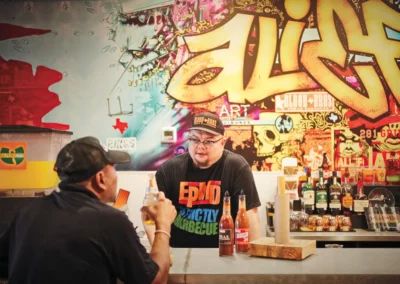Meat Me in Houston
About 2.3 million people live in Houston, most of them willingly. I wanted to know why. But I would have little time there – just the bookends of a two-day conference. So, I decided to do a small thing well. I would eat barbeque.
Though a small thing in the context of life, this was no small commitment on my part. I was in the third week of a 12-week, medically supervised weight-loss program. I was to be eating one meager tailored entrée and five shakes a day. My coach was already skeptical of my “out-of-the-box” choices, selected in lieu of the allowed cereal, soup, and nut bar that my celiac disease won’t tolerate. Carl reluctantly accepted some of those, but there would be no way for him to excuse what I was considering.
Chambers of Commerce all across the South and much of the Midwest promote each region’s barbecue style. Of course, Texas being Texas, it has more than one. Even Houston, with its enormous and diverse population and its build-what-you-want where-you-want sprawl, is too big for a single style. Over the past 100 years, influences from other regions and states have produced a diversity of barbecue, a richness impossible to sample in two meals. Which two places to go?
Houston’s barbecue scene is so central to its culture that there’s a website called Houston BBQ Guide. https://houbbqguide.com
It features restaurant search filters (11 categories! Not just styles, though there are nine choices there. Pit type? Primary wood? Sausage in-house?), history lessons, profiles of more than two dozen restaurants, even a BBQ 101 page. There are no ads. Restaurants do not pay to be featured. Most of the content is by the Houston Chronicle’s barbecue columnist, J.C. Reid. Wait. Barbecue columnist? The San Diego Union can’t even support a restaurant columnist anymore. Another sign of California’s decline.
Anyway, based on a recommendation from one of our Houston co-workers, three out-of-town colleagues and I went straight from Houston’s Hobby airport to The Pit Room.
The Pit Room features Central Texas (“CTX”) style, characterized by an emphasis on beef. Deep smoking makes sauce superfluous. We ordered this for our party of five.

Absolutely phenomenal. The pulled pork immediately pulled me away from my weight-loss program. The brisket was excellent. Loved the beef link, but skipped the jalapeño link out of caution. The beef rib, big enough to be a hood ornament, defeated two of us before I moved in for the kill. The pork ribs went fast. I think I was the odd man out on those. But just as well. I was already on thin dietary ice.
Meetings filled the next day. I squeezed in three shakes. I ignored the bowling-alley food at the company social event that night. Every calorie skipped then would leave room for one worth twice as much tomorrow.
I knew where I wanted to go on our way to the airport. I had read about Blood Brothers BBQ in Smithsonian magazine in November 2019. I said to myself, if I ever get to Houston, I am going there.
It’s because of the owners’ story. Brothers Terry and Robin Wong and high-school friend Quy Hoang grew up in the gritty Houston neighborhood of Alief. They had chosen to take on an institution long marinated in tradition and secret techniques. And though some items on the menu show Asian influence, the Texas Trinity (brisket, pork ribs, and sausage) remains holy. The Smithsonian quoted Pitmaster Hoang on that topic.
“We didn’t want to get niched. We don’t want it to be ‘Oh, those are the Asian guys.’ We wanted to do the Trinity so well that nobody could say anything about it.”
My palate says they nailed it. The brisket was especially divine, more tender than the finest filet at any steak house. And the Asian dishes? Smoked turkey banh mi, beef-belly burnt ends with Korean gochujang sauce, and brisket fried rice. The last one was the best side I tasted in Houston.
Since the Smithsonian article, Blood Brothers BBQ has been featured in The New York Times and Bon Appetit. Good call.
My on-line food log for those two days in June is empty. I had some splainin to do.



